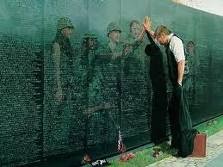Image of Vietnam Reflections by Lee Teter retrieved on November 19, 2010 from: http://www.qsl.net/n/n6tx//veteran/
This painting is of a man visiting the Vietnam wall. He appears to be a Vietnam vet visiting the wall to see the names of some friends he lost during the war. It is obviously many years after the war and his life has moved on. He appears to be no longer a soldier, but a businessman of some kind. As he touches his hand to the wall, the men he is visiting appear as reflections. He seems to be lost in thought or weeping. I have always thought the hand touching his and the man attached to it is him, when he was a soldier. Perhaps that part of him that was young and innocent; lost during the horrors of war.
Pathos is evident in the painting. Pathos is something which appeals to our emotions. The emotion of grief, of having lost friends or part of oneself is evident. The man is trying to reconnect with his past and what he left behind there. This is shown by his physically touching the wall. His head is hung low, indicating his grief and sadness. One could also see that his business attire and that he survived the war as representative of survivor’s guilt. He continued on in life, while the men left in Vietnam cannot continue their lives and become successful. They are gone, and he goes on without them.
Mythos is also in the painting. Mythos is something that refers to familial feelings, patriotism or shared social mores. The flag at the bottom of the wall, and the wall itself, are symbols of patriotism. I would say that familial feelings are represented in the reflections of the lost soldiers. Groups of soldiers are often referred to as “bands of brothers.” The man in the painting has lost his brothers, and we can all relate to the loss of family members.






